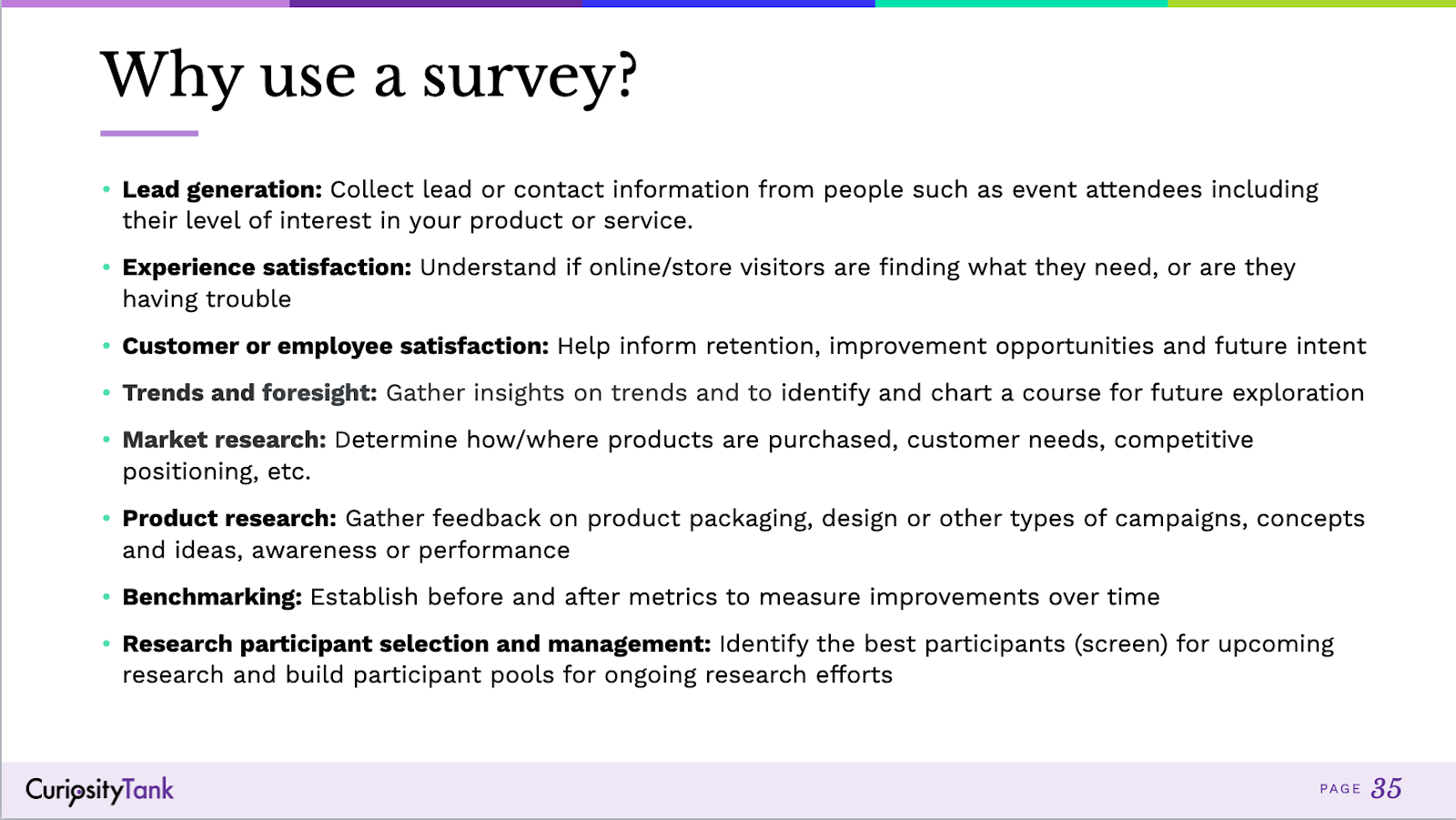Surveys? I’m more of a qual gal…
As a UX researcher who focuses more on qualitative studies, I love planning a great workshop and conducting a series of in-depth interviews. There are times, though, when a survey — usually thought of as the domain of the quant folks — is the best way to gather the information our stakeholders need. You might choose a survey to …
collect leads or contact information for potential customers
gauge “experience satisfaction”
quickly measure employee or customer engagement
identify trends or priorities
determine a position for a product in a particular market
gather feedback on packaging, design, campaigns or concepts
establish performance benchmarks
Screen qualitative research participants
That last bullet’s key — screening your participants is a key reason for a qualitative researcher to have a decent survey game, at minimum. If you haven't been screening your participants up until now, you absolutely should. I'm not a big quant person; it's just not what I do. But I absolutely, positively, am super confident and proficient at developing survey screeners. When you have those juicy sessions lined up, whether moderated or unmoderated, a well-designed screener ensures you’ll be gathering the feedback from the right people!
Your survey screeners can do double duty!
My survey screeners (or recruiting screeners) usually serve a second purpose: I also use them as a way to get directional information — perhaps on one hypothesis or the assumptions from my stakeholders, or maybe for something about my segmentation. I use the smoke signals gathered in the surveys to inform what I am going to write in the discussion guide, how I'm going to author the questions, perhaps some activities within there, and maybe how I'm going to segment the different audiences.
While you should always screen your participants, you don’t have to reinvent the wheel for every study. My personal preference is that if I’m running more than three or four studies with the same group of people or on the same product or service or feature within a year, I develop a participant pool screener instead of a screener specific to a study. I keep that screener rolling so I always have quality, and qualified, participants available as I continue to collect smoke signals.
Practice makes perfect.
This week, my Ask Like A Pro All-in students are creating survey screeners for the real-world research projects they’re conducting as part of the workshop series. We’ll identify who to recruit and discuss how to maximize the number of responses, write and distribute their survey screeners, learn when to use different question types, and design question sequences that move from surface data gathering to deeper understanding. We also cover Likert scales (download my favorite Likert tool here), intercept interview/surveys, intercept recruitment, pros and cons of online surveys, and much more.
I always enjoy seeing how the All-in students grow in this area, and, with today’s ever-growing field of survey tools, often we learn from each other!
If you’re focused on qualitative research, be sure to take some time to work on your survey design skills. Maybe you’re more of a “mixed methods” kind of person than you think!
Speak up, get involved, share the love
Follow me on LinkedIn for more UXR tips and UX discussions
Read about Curiosity Tank workshops
Participate as an On-Demand, or as an Observer, for less!
Register for Michele's General Assembly classes (the next classes starts on 6/13). Use discount code ronsen-2021 for 25% off!)
Forward this email to someone who you think might enjoy it. Better yet, sign them up here. It will be the gift that keeps on giving.
Ask us questions related to user research. Seriously, bad research keeps us up at night!
And that's a wrap!
We try to alternate between a theme and UX/UXR jobs, events, classes, articles, and other happenings every few weeks. Thank you for all of the feedback. Feedback is a gift and we continue to receive very actionable input on how to make Fuel Your Curiosity more meaningful to you.
What do you think? Lmk. We're constantly iterating and would still love to hear your input.
Stay curious,
- Michele and the Curiosity Tank team



